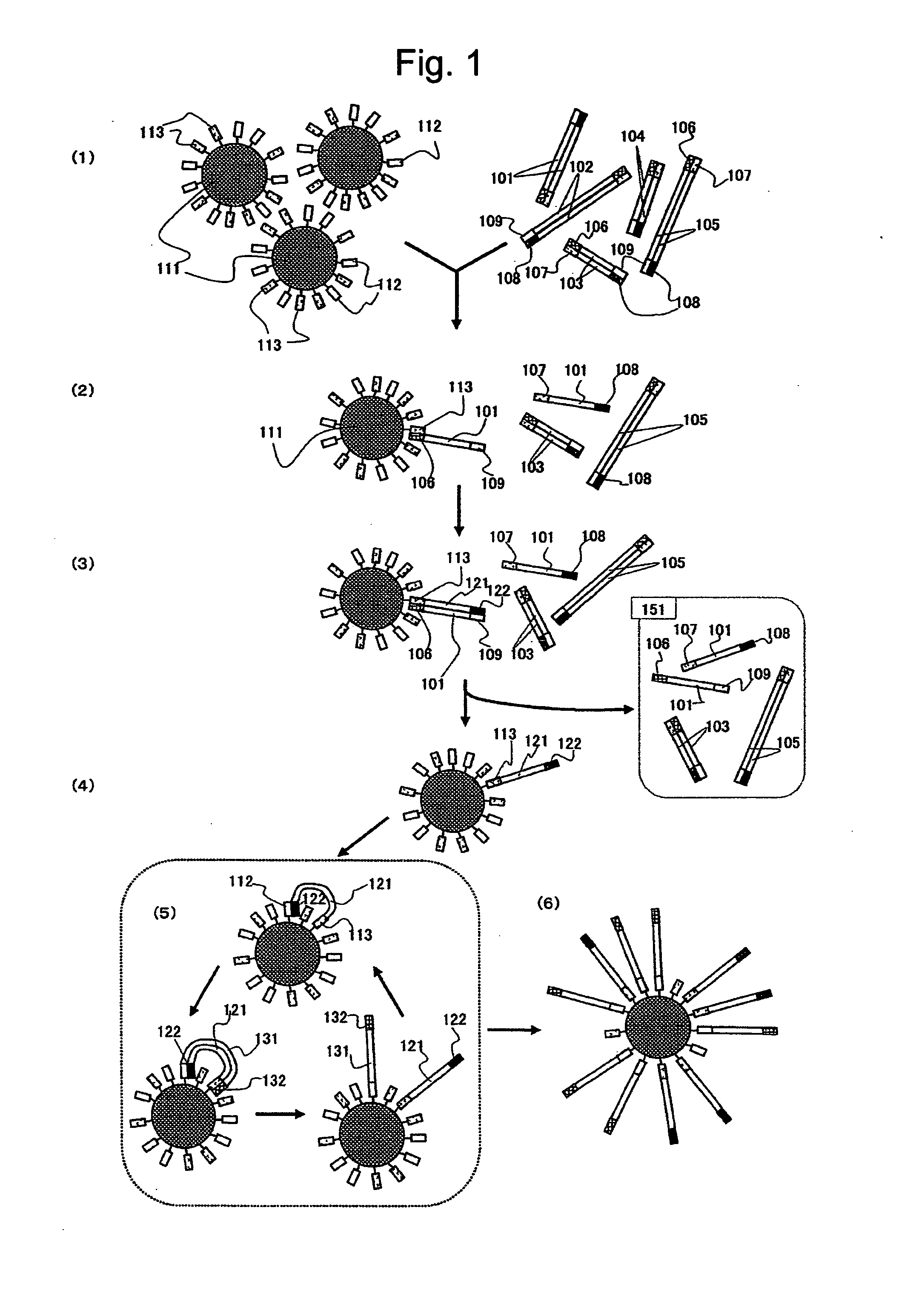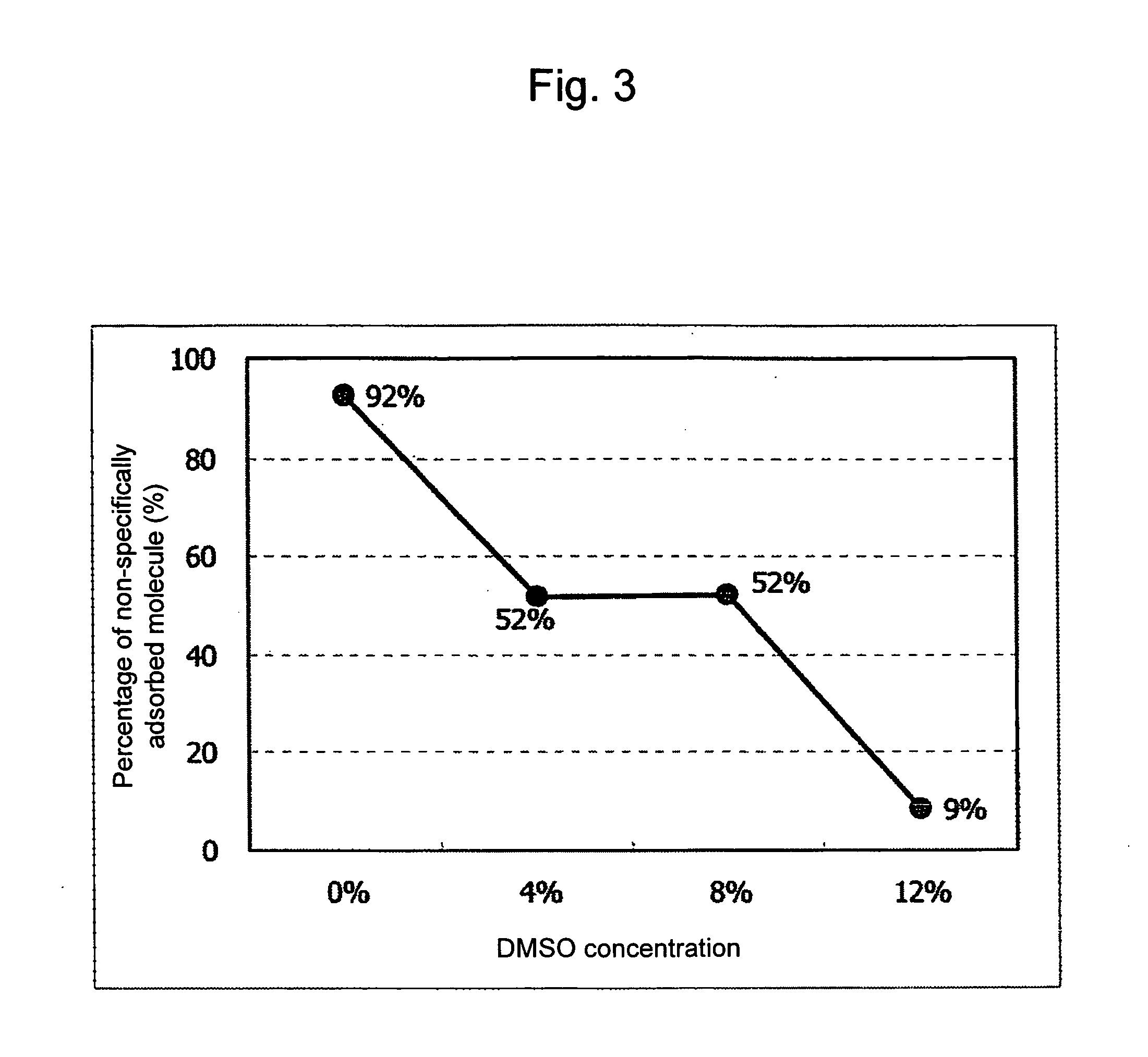Large-scale parallel nucleic acid analysis method
a nucleic acid and analysis method technology, applied in the field of large-scale parallel nucleic acid analysis method, can solve the problems of inability to cleave, low treatment efficiency, and exceedingly difficult to uniformly develop the addition of nucleic acids to be amplified
- Summary
- Abstract
- Description
- Claims
- Application Information
AI Technical Summary
Benefits of technology
Problems solved by technology
Method used
Image
Examples
example 1
[0158]The steps of the present Example are schematically shown in FIG. 1. Magnetic beads (2.8 μm in diameter; Dynal BIOTECH) activated with carboxylic acid groups were used as solid phase carriers. 50 μL (1×108 beads) of a solution containing the carboxylic acid group-activated magnetic beads well suspended in advance was measured into a 2.0 mL microtube. Magnets were placed on the side wall of the tube, and the supernatant was removed with the magnetic beads captured. To wash the beads, 100 μL of a MES Buffer (25 mM MES (2-Morpholinoethanesulfonic acid) (pH 6.0), 0.1% (w / v) Tween 20) was added thereto, and the mixture was stirred and shaken at room temperature for 10 minutes. Then, the supernatant was removed. This step was repeated again, and the supernatant was removed. Subsequently, 30 μL each of solutions of probes A and B diluted to 2.5 pmol / μL with a MES buffer was added thereto, and the mixture was stirred and shaken at room temperature for 30 minutes. The probes A and B com...
example 2
[0164]Magnetic beads (2.8 μm in diameter; Dynal BIOTECH) activated with carboxylic acid groups were used as solid phase carriers. 50 μL (1×108 beads) of a solution containing the carboxylic acid group-activated magnetic beads well suspended in advance was measured into a 2.0 mL microtube. Magnets were placed on the side wall of the tube, and the supernatant was removed with the magnetic beads captured. To wash the beads, 100 μL of a MES Buffer (25 mM MES (pH 6.0), 0.1% (w / v) Tween 20) was added thereto, and the mixture was stirred and shaken at room temperature for 10 minutes. Then, the supernatant was removed. This step was repeated again, and the supernatant was removed. Subsequently, 30 μL each of solutions of probes A and B diluted to 2.5 μpmol / μL with a MES buffer was added thereto, and the mixture was stirred and shaken at room temperature for 30 minutes. Then, 30 μL of an EDC solution (adjusted to 0.1 mg / μL with a MES Buffer) and 10 μL of a MES buffer were added thereto, and ...
example 3
[0169]An important thing in the present invention is a mixing ratio between the beads and the DNA fragments. To achieve one bead-one nucleic acid, a reaction solution containing 103 or less DNA molecules must be prepared according to Poisson probability shown in FIG. 2, whereby the number of a bead comprising two or more molecules immobilized thereon can be one or less in a reaction system using 106 beads. According to this calculation, 998,400 beads corresponding to 98.4% of the whole are bound with no DNA fragments. The throughput of the amplified product analysis step can be improved dramatically by separating only the bead bound with the DNA fragment, from which products were obtained at the subsequent amplification step.
[0170]In the present Example, an anchor sequence for separation was added as separation means to a probe sequence introduced at the terminus of the amplified product, and the separation was performed by use of a column bound with a probe complementary to this an...
PUM
| Property | Measurement | Unit |
|---|---|---|
| particle size | aaaaa | aaaaa |
| temperature | aaaaa | aaaaa |
| temperature | aaaaa | aaaaa |
Abstract
Description
Claims
Application Information
 Login to View More
Login to View More - R&D
- Intellectual Property
- Life Sciences
- Materials
- Tech Scout
- Unparalleled Data Quality
- Higher Quality Content
- 60% Fewer Hallucinations
Browse by: Latest US Patents, China's latest patents, Technical Efficacy Thesaurus, Application Domain, Technology Topic, Popular Technical Reports.
© 2025 PatSnap. All rights reserved.Legal|Privacy policy|Modern Slavery Act Transparency Statement|Sitemap|About US| Contact US: help@patsnap.com



